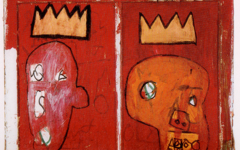Basquiat’s Untitled (Call Girl) (1983)

Basquiat, Untitled (Call Girl) (1983) Acrylic and oil stick on canvas. Private Collection
Click image to enlarge.
Successful contemporary artists may not embody the level of craft common in the Renaissance but they are often far more adept at handling a brush and pen than they let on. Basquiat is a good example. Those who knew him commonly report that the pen danced in his hand in what amounted to a kind of performance art. He also knew the underlying methods and meanings of past masters. In this example, a woman (described as a "Call Girl" in the title) smokes a cigarette to indicate how intoxication stimulates the imagination. Smoking as a symbol for the imagination has long been extremely common, starting as far back as the Dutch tavern paintings of the seventeenth century.
Click next thumbnail to continue
In the foreground lies a long, rectangular shape easily confused with a cigarette but more likely to represent an oilstick, one of the implements used to create the image and its own shape. Next to it lies a circle, perhaps a tray, on which lies yet another oilstick and some associated tools. It is Basquiat's modern equivalent to the circular- or oval-shaped palettes of earlier art. Together, the stick and tray reference the actual artist in the studio but in also forming the letter P may additionally refer to Picasso or another creative figure whose name begins with P and who inspired Basquiat.
Click next thumbnail to continue

Left: Detail of Basquiat's Untitled (Call Girl); Right: Reverse of Basquiat's Untitled (Call Girl)
Click image to enlarge.
We know that the P-shaped form is likely to reference an artist's name because the squiggle above it and next to it looks more like an excerpt from the artist's own signature (as seen on the reverse of the same canvas) than any specific object.
Click next thumbnail to continue
Most tellingly, the left-hand side of the woman's face is blacked out as if vigorously erased by oilstick. Although Basquiat intended most people to read that dark area as the shaded side of the face, those in-the-know will recognize it as too aggresively dark for mere shading. It must mean more, more likely representing an erasure of the unseen eye to symbolize insight. As seen in many other examples under the theme Insight-Outsight, one eye is open for normal perception here, the other "closed" for insight.
See conclusion below
Whether or not Basquiat intended the woman to be identified as a call girl, she is clearly drawn to suggest a woman smoking after intercourse. She represents the artist's female side, the other half of his androgynous mind, using sexual intercourse as a symbol for conception, a long-established tradition used in Titian's Venuses, Manet's Olympia and numerous other paintings of nude women. Basquiat's paintings on the surface are far removed from those of earlier centuries but in their veiled use of self-referential figures, metamorphic shapes and creative symbols they have far more in common with past art than even his most ardent supporters appreciate.
More Works by Basquiat
Notes:
Original Publication Date on EPPH: 31 Jan 2012. | Updated: 0. © Simon Abrahams. Articles on this site are the copyright of Simon Abrahams. To use copyrighted material in print or other media for purposes beyond 'fair use', you must obtain permission from the copyright owner. Websites may link to this page without permission (please do) but may not reproduce the material on their own site without crediting Simon Abrahams and EPPH.





